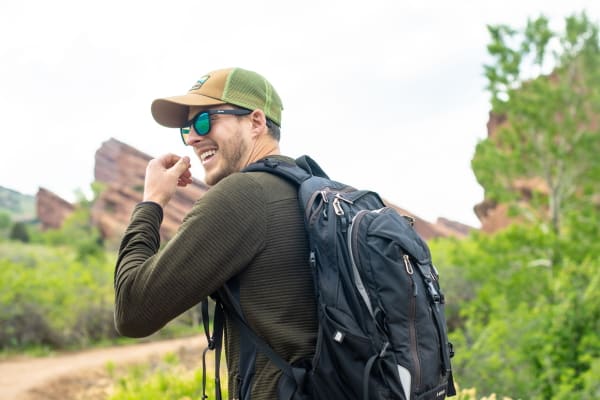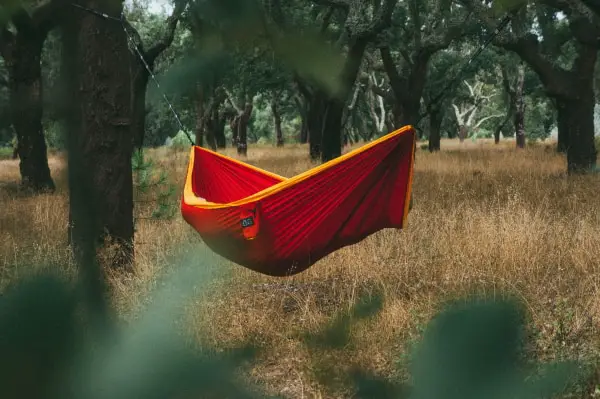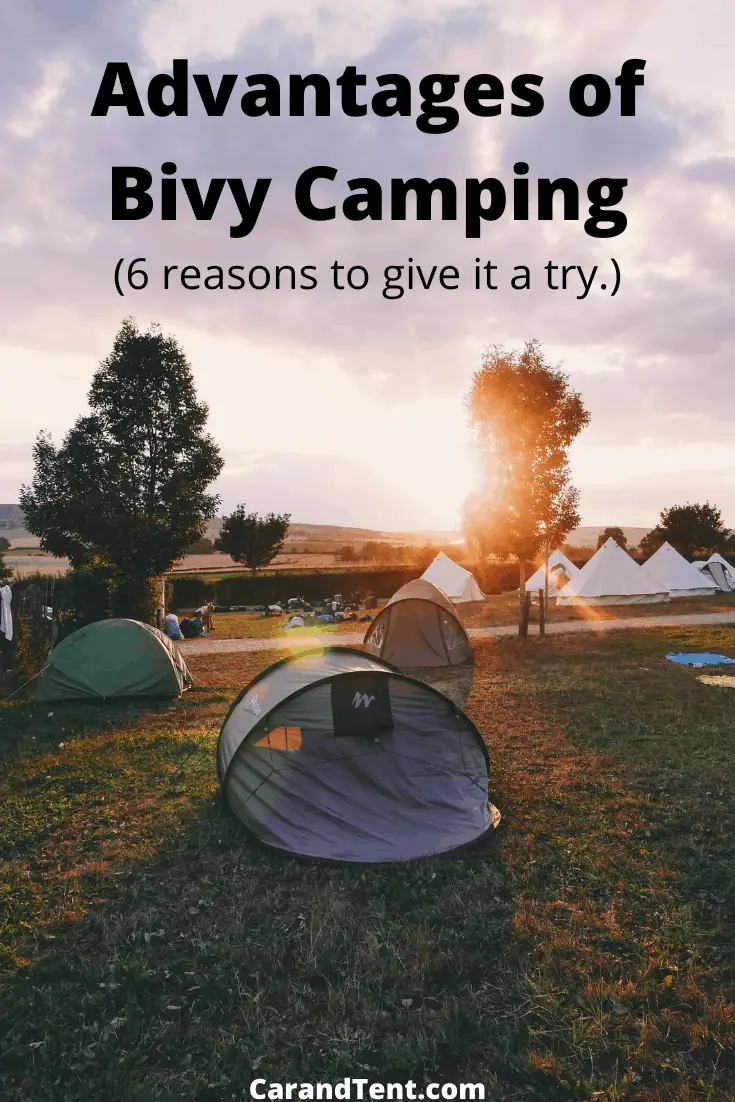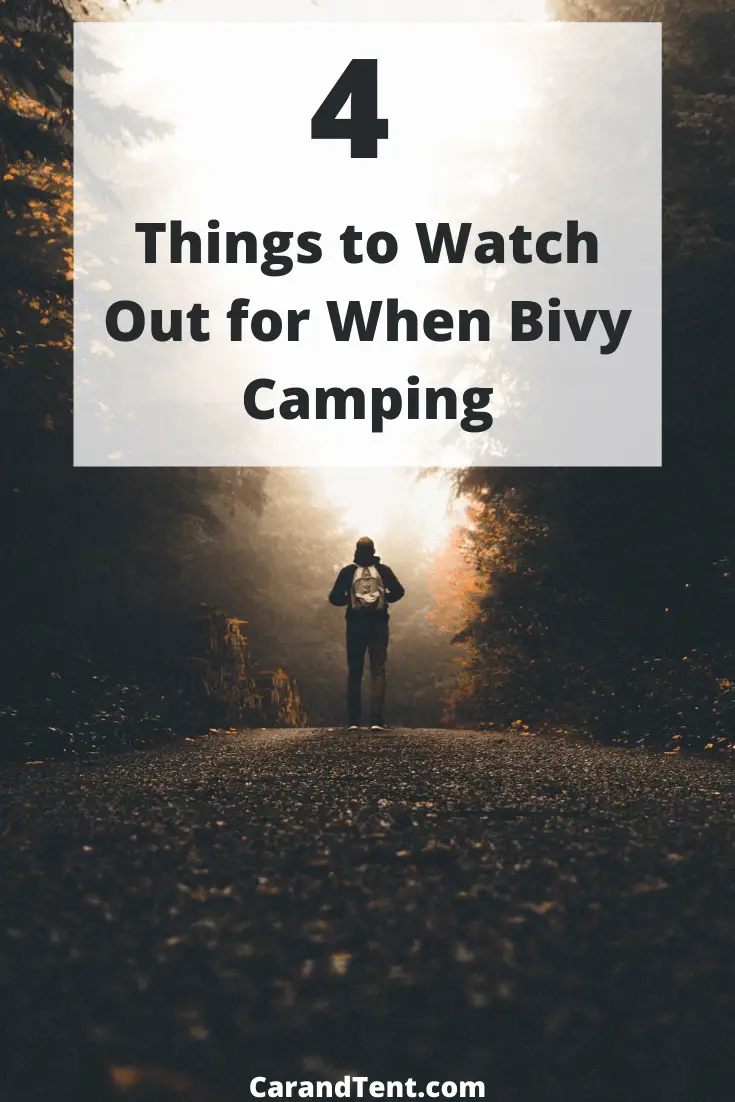
Bivy camping setups are popular among backpackers but they aren’t as well known as some of the other shelter setups. In this post, we’ll tell you everything you need to know about bivy camping. By the end of it, you’ll know enough about it to give it a try yourself.
Table of Contents
What is Bivy Camping
Before we can talk about what bivy camping actually is, we have to define what a bivy is. The word bivy is actually short for the word bivouac. It’s essentially a personal waterproof shelter with just enough room for one person to slip into. In addition to protection from the rain, this shelter also provides some insulation as well as protection from the wind, from insects, and from bugs.
This shelter can be used with or without a sleeping bag and is often used in conjunction with a small sleeping pad which is strapped inside of the bivy. The bivy generally comes in two different styles which include the bivy shelter and the bivy sack.
Bivy Sacks
A bivy sack doesn’t look much different than a sleeping bag. However, there are some significant differences and a sleeping bag can’t take the place of a bivy sack. This being said, a bivy sack can sometimes take the place of a sleeping bag.
The bivy sack usually has a thick waterproof material on the bottom and a thinner waterproof material on the top of it. It’s fully enclosed but will have an opening at the top.
This opening can be used to get in and out of the bivy sack and it can also be used for ventilation. In some cases, there may be some additional ventilation openings. These openings will often be covered in a mesh material so that you can get ventilation without having to worry about getting eaten alive by mosquitos, ticks, and other bugs and insects.
The material used for the upper part of a bivy sack is generally Gore-Tex but nylon can be used instead as it tends to weigh less. I prefer Gore-Tex as it’s waterproof on the outside but will let moisture out from the inside.
Before the advent of Gore-Tex, the ventilation openings were a crucial component for reducing condensation within the bivy sack. With Gore-Tex, ventilation is important, but not to the extent that it once was.
Bivy Shelter
A bivy shelter is a bivy sack with structural components built into it. In fact, some people simply refer to bivy shelters as structured bivy sacks instead.
The structural components of the bivy shelter help to elevate the bivy sack off of a person’s body. This makes getting in and out of the shelter easier and helps to keep the top of the shelter off of a person’s face.
A simple shelter might consist of a bivy sack with a space for a tent pole to be inserted near the top portion of the sack. This tent pole gets placed in, semi-circle style and it keeps the sack elevated at the opening. Think of it as a miniature half-dome tent for your upper body.
The Bivy Shelter Vs The Bivy Sack
Here are the advantages that bivy shelters have over bivy sacks.
- Bivy shelters have less condensation.
- Bivy shelters are easier to get in and out of.
- A bivy shelter may feel less claustrophobic.
Here are the advantages that bivy sacks have over bivy shelters.
- Bivy sacks weigh less than bivy shelters.
- Bivy sacks don’t require as much set up as bivy shelters.
While bivy sacks and shelters are slightly different than each other, they can be much different from other types of camping and backpacking shelters. In the rest of this post, we’ll go over the advantages and disadvantages that they have over more traditional camping options like camping and backpacking tents.
What are the Advantages of Bivy Sacks and Bivy Shelters
Bivies have many advantages over traditional tents, hammocks, and even tarp setups.
These advantages include:
- They’re extremely lightweight.
- They don’t take up a lot of space.
- They provide excellent protection against the wind and the rain.
- They don’t require a lot of setup.
- They provide additional insulation.
- They offer a great view.
Bivy Weight
A bivy is much lighter than even an ultralight tent. In fact, the average bivy might weigh only a pound and some weigh even less.
To put this into perspective, even an ultralight tent is going to weigh two or three pounds.
Space Considerations
Bivies don’t take up much space either. This is good for packing your backpack as well as for picking out a spot to camp for the night. Many mountaineers use bivies as they can set them up on ledges that simply wouldn’t be conducive to using a tent.
Wind and Rain Protection
The bivy also provides great protection against the wind and the rain.
By contrast, a tarp won’t always provide complete protection from the wind and it won’t stop rainfall from running underneath of you. It also will not stop rain from blowing sideways onto you.
On the other hand, a hammock with a tarp might provide great protection from the rain but it won’t provide much protection from the wind. This could lead to a cold night’s sleep.

Even a tent might not provide as much protection from the rain and wind as a bivy will. This is because tents can flood or drop condensation on you and a tent won’t always stand up to high winds.
On a side note, if you’re having trouble with the inside of your tent getting wet, see my post titled, “Why Does the Inside of My Tent Get Wet and What to Do About It“.
Minimal Setup Requirements
Hammocks and tarps need to be hung and tents need to be pitched. Bivies don’t have these problems.
A bivy shelter just needs one pole to be lifted and maybe a few stakes to be driven into the ground so that it doesn’t blow away when you’re not in it. Bivy sacks require even less setup and you may only have to shove your sleeping pad into it before drifting off to sleep for the night.
Extra Insulation
Many bivies are said to add another 10 degrees of warmth to your sleeping setup. This means that your 30-degree sleeping bag will become a 20-degree sleeping bag with a bivy wrapped around it.
Tarps, tents, and hammocks don’t provide this benefit. As a result, you may end up having to buy a different sleeping bag for colder weather when you wouldn’t have had to do so if you had opted to camp with a bivy instead.
A Room With a View
Have you ever left your tent fly off of your mesh tent, only to wake up to rain falling onto you and into your tent? You then had to quickly rush out of your tent so that you could grab your rainfly and put it on to keep you from getting wet.
By the time you finished, the inside of your tent and all of your gear may have been wet. In the future, you probably avoided this by using your rainfly even on nights when you didn’t need it.
With a bivy, you don’t have this problem. Wake up to rainfall and all you have to do is grab the top enclosure and pull it over you. This means that you can fall asleep under the night sky, drifting off as you gaze up into the stars.
What are the Disadvantages of Bivy Sacks and Bivy Shelters
- They don’t offer much room.
- They can cause a lot of condensation.
- You can’t share them with others.
- You may be more vulnerable to bears, mountain lions, and other animals.
Interior Space
A bivy offers just enough space for a sleeping pad, a sleeping bag, and a person. This means you won’t be able to store any of your gear inside of your shelter.
What this also means is that you won’t have any room in your shelter to spend time in. Imagine you’re on a backpacking trip and you get stuck in one place for a day while you ride out a storm.
Now imagine you don’t have a shelter to sit inside of while you wait this storm out. You’ll either be laying on your back all day long or you’ll be out in the rain or the snow.
Fortunately, these aren’t your only options. One way to get around this would be to pack a tarp with you.
This way, you could sleep in your bivy and use the tarp as a place to hang out in when you’re not sleeping or hiking. Even with a bivy and a tarp, your pack will still weigh a lot less than if you had brought a tent.
Condensation
A bivy shelter and especially a bivy sack is bound to collect more condensation than a typical tent. The main reason for this is that it only has one layer. This means that the warm air of your bivy sack walls will be directly exposed to the cold air of the outside.
Also, bivies are closer to your body so you don’t have much space between the body heat your body is generating and the outside air either. As such, a fully closed bivy sack or shelter is much more likely to get wet inside.
The best way to reduce this condensation is to leave the top open. This way, you’ll get plenty of airflow and you won’t have to worry about condensation at all.
Also, bring a tarp to use in rainy weather. You can then set the tarp up over your bivy so that you can leave the bivy open at the top without worrying about getting wet.
Sharing
If you’re looking to share your shelter with someone, the bivy shelter probably isn’t the right option for you. A two-person tent might be cramped with two people in it, but at least it’s possible for you to both have enough room to fit inside of it.
I’ve seen a few two-person bivy shelters and sacks for sale, so it is possible for you to buy one that two people could fit into but I can’t imagine it would be comfortable for either of you. If you’re looking to share your shelter, opt for a tent or tarp set up instead.
Vulnerability
The bivy sack is often fondly nicknamed the “bear burrito”. Incidentally, it could also be called a “mountain lion burrito” as well and for the same reason.
This nickname stems from the fact that a person is a bit more likely to be attacked while sleeping in a bivy versus sleeping in a tent. Reason-being, a bear or mountain lion sees you as being more vulnerable in a bivy than in a tent. This is because when you’re in a closed tent the animal can’t see exactly what’s going on inside and is more fearful of attacking.

To guard against this disadvantage, the best thing to do is to follow proper food-safety protocols for your area and to avoid cooking in the same area you’ll be sleeping in. Also, it isn’t a bad idea to stick with tent camping in areas with mountain lions.
Not sure if there will be mountain lions at your next camping destination? Check out this post on camping and hiking with mountain lions.
When to Use a Bivy System and When Not to
Technically, you could use a bivy shelter or sack in all conditions. The only caveat is that you might want to bring a tarp and some trekking poles with you in case you need more shelter than the bivy has to offer.
This being said, here are the times when I’d use a bivy and the times when I would use something else instead.
Use-Cases for Bivy Sacks and Shelters
The best use-cases for bivy systems are when you’re backpacking or bike packing and need to cut down on weight. Preferably, you’ll also be in a dry area so that you do not have to fully close your bivy shelter every night.
Another time when you might want to use a bivy is when you’re on a mountaineering trip. A bivy will be easier to set up on small ledges and it’ll provide you with a bit of extra warmth.
One other recommendation is to always have a small bivy on you when day hiking. Bringing this item along with you won’t add much weight or take up much space in your daypack, but it will provide you with a bit of extra safety in case you get stuck out on the trail overnight.
When Not to Use a Bivy Sack or Shelter
I’ve been up close to non-aggressive bears before and while I felt blessed to be able to see them in the wild, I was also terrified at how large they actually are up close. Because of this, I want all of the protection I can get while sleeping in the backcountry. For this reason, I’d opt for a tent in grizzly bear and mountain lion country.
I’d also prefer to use a tent over a bivy when camping in conditions that require a more robust shelter for spending time in. This could be stormy conditions but it could also be desert camping conditions as well. I couldn’t imagine having to wait out a sand storm while lying in a bivy sack.
How to Use a Bivy
Using a bivy is pretty straightforward. You won’t really need to put anything underneath of them but you will want to put a sleeping pad inside of them.
To keep the bivy from blowing away on you, you may need to stake it down. Your bivy shelter will most likely come with a set of stakes and loops to send them through.
If you’re feeling lazy, you could also just throw a heavy backpack over the top of it as well. Once you go to sleep, the weight of your body will keep the bivy from going anywhere. On clear, windless days, I’ve been known to do this with my tent as well, although I wouldn’t advise it.
You’ll also need to find a good place to set your bivy up as well. Choose a bivy campsite is even easier than choosing a tent campsite. You’ll basically just need to find a place that won’t flood and that’s away from any trees or rocks that might fall on you.
In fact, some bivy systems are so waterproof that you can drop them on top of a small puddle of water and go to sleep without having to worry about waking up wet. This is what the bivy sack that comes with the military sleep system is like.
How to Choose a Bivy
Choosing a good bivy system mostly comes down to personal preference. If you’d prefer a little more space in your bivy, you’ll probably want to go with a structured bivy sack or bivy shelter.
On the other hand, if weight is your biggest concern, you may want to go with a bivy sack. This being said, both options will be much lighter than any tent you might buy.
For harsh weather conditions and for areas with harsh terrain, you may want to choose a bivy with a thicker material. Thicker and stronger materials will weigh a bit more but they’re less likely to puncture and they’ll provide a bit more insulation.
Of course, you could always go with thinner material and just pack a ground cover with you when venturing into rough terrain. Choose a tarp for your ground cover and you could use it as an overhead shelter on easier terrain.
Additional Bivy Sack and Shelter Camping Tips
Never Fully Close Your Bivy
A lot of bivy manufacturers will warn you not to fully close your bivvy. Completely close it and you run the risk of asphyxiation.
From what I’ve read, you probably won’t die from this as you’ll begin to breathe faster as your body senses the CO2 loss but you’ll wake up feeling out of breath and it won’t be pleasant. Also, it really just isn’t worth the risk – “probably won’t die” isn’t very comforting to me.
Your Sleeping Pad is Important
A bivy isn’t really going to give you any more insulation than a tent. This means that your sleeping pad will still be an important piece of gear for insulating the ground.
In warmer weather, you could opt for an inflatable sleeping pad but in colder weather, you may want to opt for something a bit sturdier. A foam pad will take up more space in your backpack but it will provide more insulation and you won’t have to worry about it deflating on you.
A Bivy is Usually Worth Carrying
Even if you decide to tent camp, hammock camp, tarp camp, or even cowboy camp, it can’t hurt to have a bivy sack with you. These items don’t take up much space, they don’t add much weight and they make great emergency items.
You may even run into somebody on the trail that has lost or damaged their tent and you could save their trip by lending them your extra bivy. The same thing could happen to your tent and you could save your own trip by switching to your bivy instead.
Ventilate Whenever Possible
Excess condensation will make you wet and uncomfortable. In colder temperatures, it can also lead to frostbite and hypothermia.
Reduce the chances of condensation forming in your bivy by properly ventilating it. If possible, leave the top completely open and just close the mesh part so that bugs don’t eat you.
Use Your Mesh Properly
The mesh screening of your bivy sack or shelter isn’t going to work if your face is plastered to it. Keep some space between the mesh and your face so that mosquitos can’t go right through it and get to you.

Also, unless you’re camping in cold weather, I wouldn’t recommend going with a bivy that doesn’t have some sort of protection against bugs and insects. Bugs and insects are more dangerous than wild animals and their effects can last a lifetime.
Bring a Tarp
You don’t have to pack a large tarp, but you should have one. Even a small tarp will give you the ability to stay dry without having to close your bivy sack during a downpour.
If you want to fall asleep while stargazing, just set the tarp up next to you. When you wake up to raindrops on your face, you can just roll over until you’re under the tarp again.
Consider a Footbox for Cold Weather
People looking to backpack or mountaineer might want to consider getting a bivy sack with a foot box. This foot box will allow them to store their boots and their clothing inside where it’s warm.
Warm weather bivy campers might also want to consider a foot box for storing their boots in. This will bring the chances of waking up with a snake in their boots down to zero, or at least 99.99%. After all, nothing is really 100%.
I saw a man on the news last week that found a 6-foot boa constrictor in his couch while searching for his keys. He had no idea where it came from.
Give Yourself Time to Adjust
Bivy camping is different than tent camping and you’re bound to feel uncomfortable the first few times you use one. My advice is to try the bivvy out on at least a few short trips before deciding whether you like it or not.
You may find through experience that you have to change your sleeping pad, your sleeping bag, or even your sleeping position while camping with a bivy.



